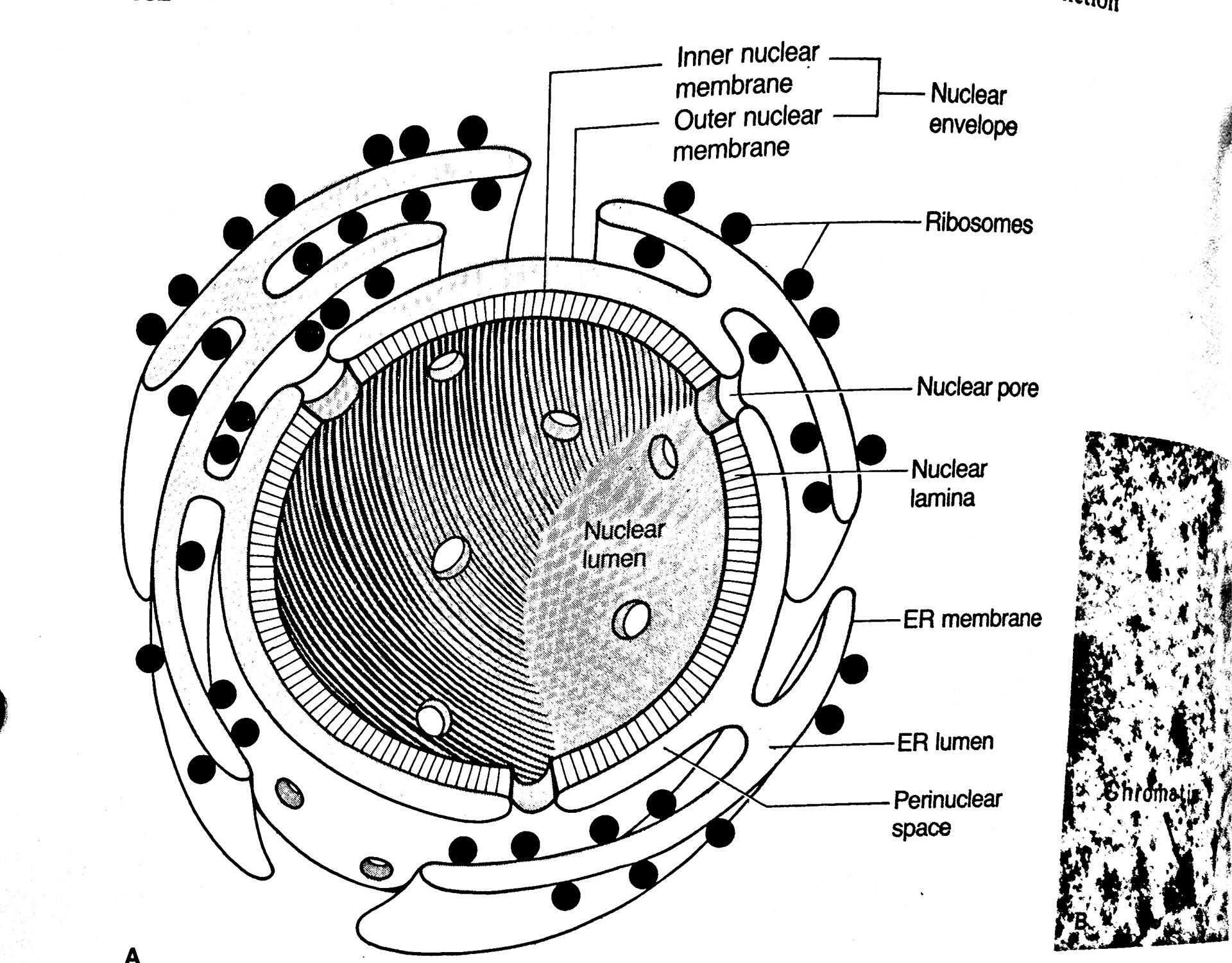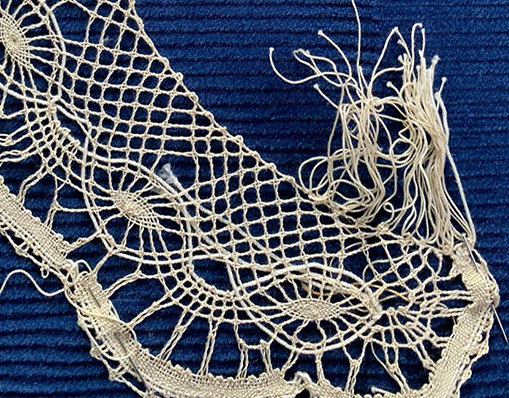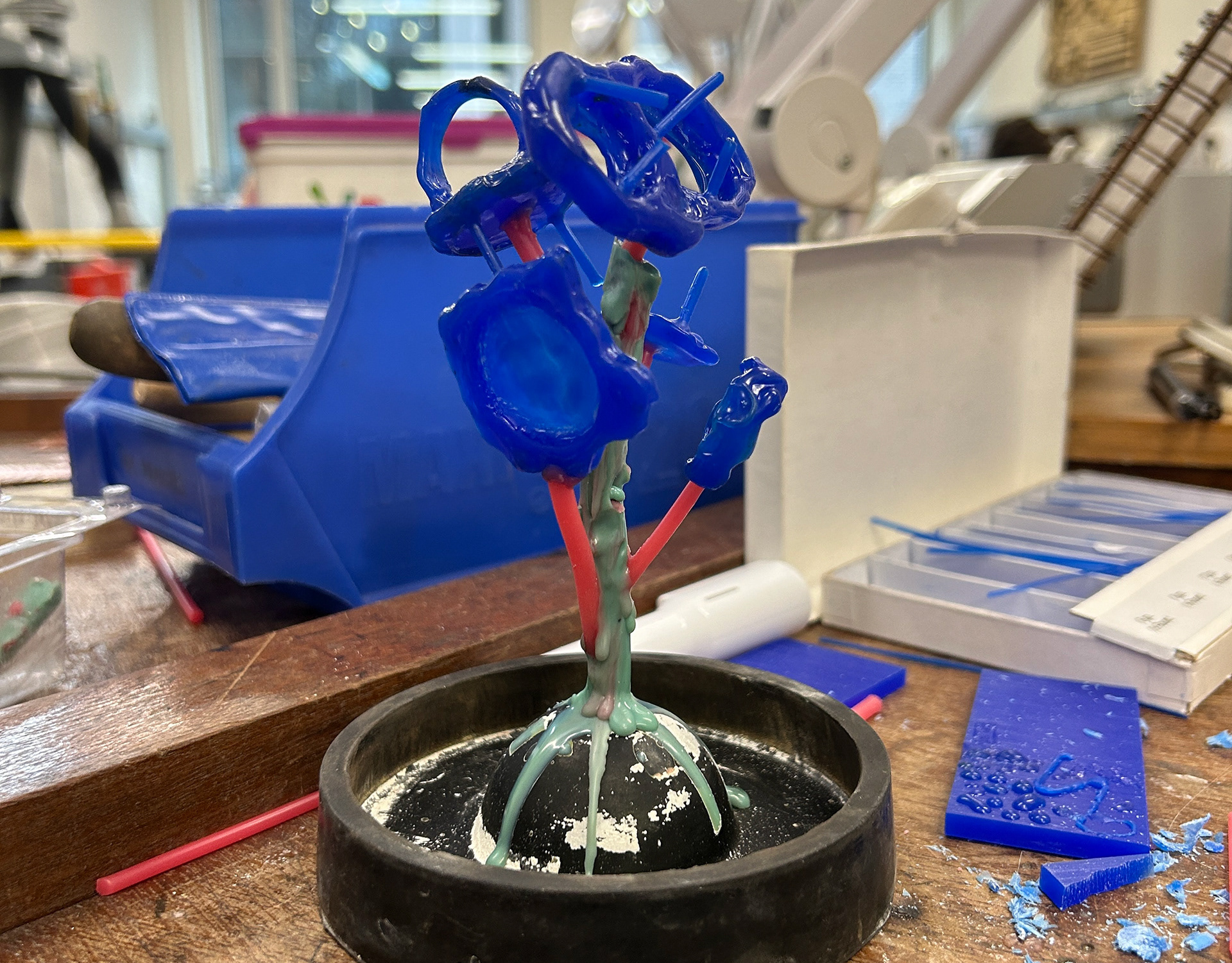Final Outcome
Exploration in Microbial Jewellery
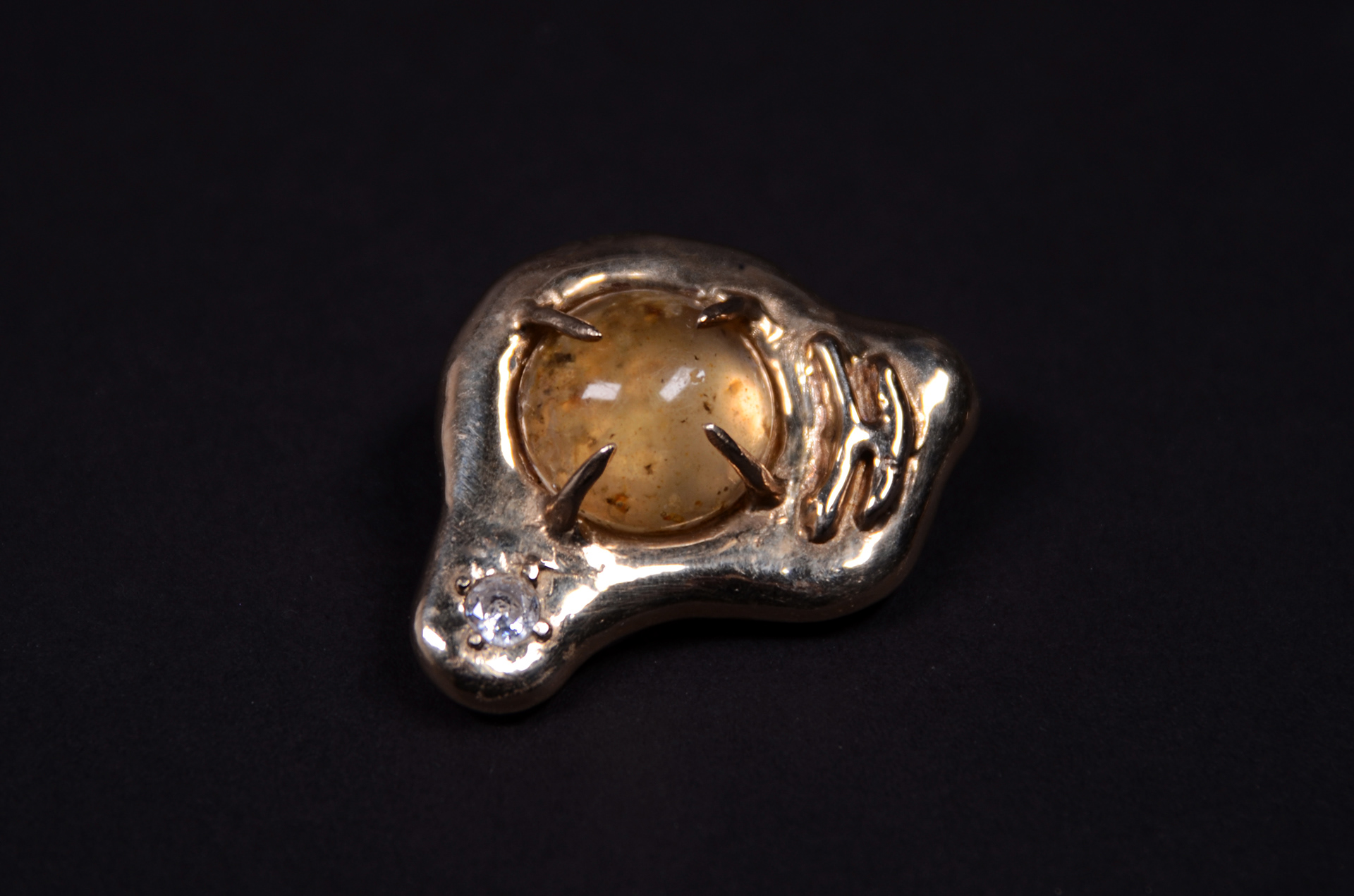


Artist Statement
My jewellery practice has developed to combine unconventional mediums with traditional jewellery materials and techniques. I have introduced bacteria as a material and the inspiration for my designs. I seek to challenge our perceptions of these microorganisms, which is usually something disgusting or feared. Instead, I aim to highlight the beauty in these natural living organisms and change the narrative surrounding bacteria. I have investigated cultivating samples from the people and places that are significant to me and have used this to create sentimental brooches. Each brooch contains a unique bacteria-infused resin stone set in a solid brass cast.
The collection utilises lost wax casting to create the brooches. Due to wax’s very low melting point, the material could be manipulated to make these brooches have the molten and curved forms that I found in the Petri dishes. I have created these designs in brass due to the material's natural antimicrobial properties, introducing a juxtaposition between the bacteria stones and the brooch they sit upon.
Cubic Zirconias are used to combine my jewellery pieces with both traditional and unconventional materials and to give the illusion that the bacteria is spreading from the central stone, engulfing the rest of the piece. Chain is used to help convey messages of connections between individuals, and the chain and brooches can be rearranged to the wearers desires, and become interactive with the wearer.
The brooches' silhouettes are inspired by the forms that the bacteria has naturally grown in while cultivating in a Petri dish. I have enjoyed incorporating unpredictability and a new organic way of designing.
Collect Open Proposal
Collect Open Stand
Proposal
My exploration into the capabilities of microbial jewellery has resulted in a small collection of brooches. Through my jewellery practice, I have utilised many different traditional techniques, while employing the use of non-traditional materials. I use bacteria-infused resin from a variety of sources to create stones for my designs, which are also inspired by bacteria.
These materials help me reconceptualise the narrative around bacteria, which is often feared and disgusted. Instead, I aim to highlight the beauty in these living organisms. My jewellery pieces serve as more than adornments; they act as conversation starters, prompting discussions on the world of microbiology and challenging preconceived notions. These creations are embedded with a sense of personal narrative while inviting the viewers to engage with both the aesthetic and contextual themes of my work.
Progressing with this theme of work, I believe that I can create a collection of jewellery which continues to challenge notions. I would trial how I can use the bacteria as a medium. Instead of only using resin to make cabochon stones, I would experiment with capturing the bacteria in the form that it grows in, and potentially cultivate the bacteria directly onto different materials. With this in mind, I could then create a different variety of jewellery, from necklaces and pendants to cuffs and bangles. I would also then experiment with smaller scales, for instance, rings. These would then form a collection suitable for exhibition.
Pricing
Final price for brooch collection: £2907
Bacteria Stones
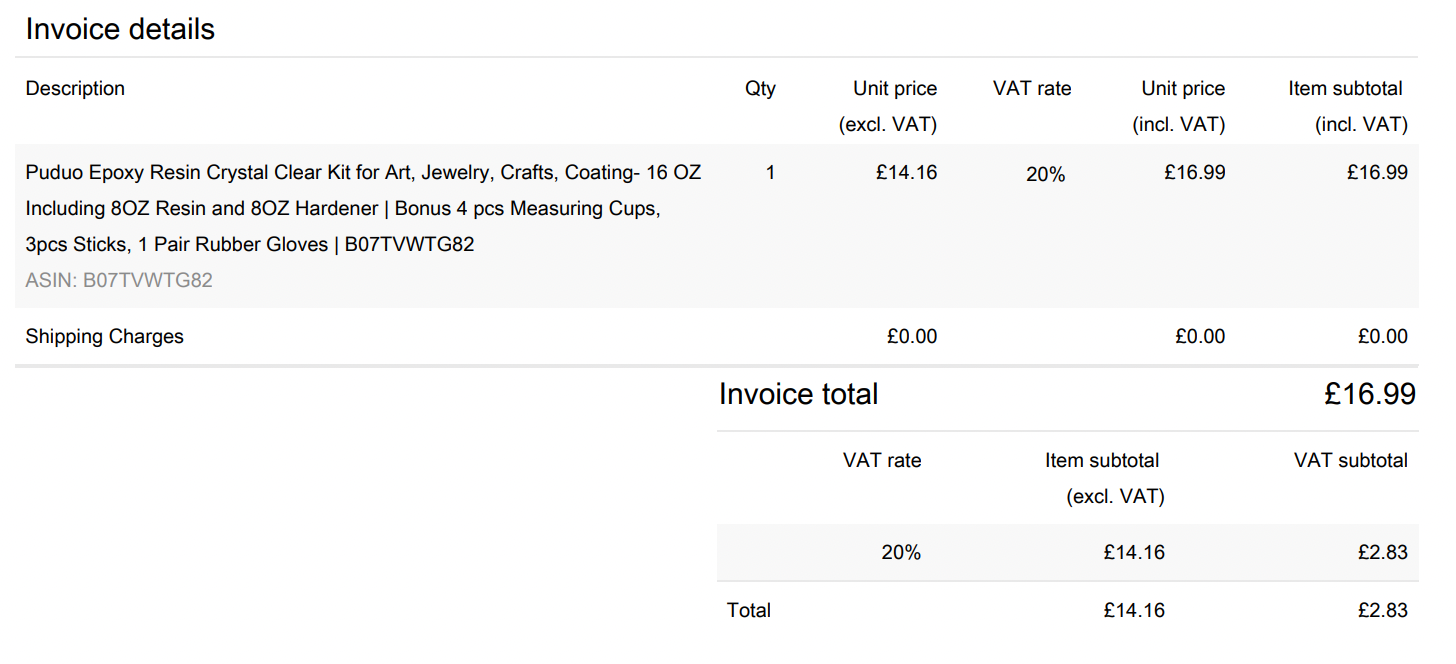

To make my bacteria stones, I used all 6 of my Petri dishes and estimated that I would need 40ml of resin. When I made my first set of stones during UC1, I initially used 60ml of resin, however, I had around 20ml left over. I had also used all 6 dishes, so I knew that this time I would need around 40ml of resin. This resulted in 30 'stones' altogether, resulting in a price of £0.42 each.
Wax Price
For my final pieces, I used the lost wax casting technique. This meant I had to calculate the value of the wax that I had used. I couldn't use the final weight piece as many of the scrap pieces of wax couldn't be reused for larger projects, only for minor corrections on different casts. This meant I had to use the dimensions instead.
As the blue wax could all be purchased from Cookson Gold, I would only need to purchase the pink wax for sprues and the brooch mechanism from a different company. I found that Cousins UK, a wholesale company, stocked the exact sprues I had used.
Casting Price



As I do not have my own casting equipment, any wax casts I make would have to be sent off to be cast. I found the company Jewellery Casting Scotland, which would make my casts out of brass. I rang them to confirm the price of brass, as Cookson Gold does not sell brass grain. They said that the price of brass casts would be £0.10 per gram of brass, and then the following charges for 'large size' casts. They also said that they wouldn't be able to confirm the price until the pieces have been cast, so this is just an estimate.
Pricing for Gold
I also decided to look at how much my pieces would be if I cast them in gold instead of brass, as many of the pieces at Collect were made from solid 14k gold. If I were to use gold, then I would make the brooches at least 30% smaller, as gold is a denser material than brass and the brooches would be too heavy at their current size. The total wax weight at full size is 22g, so 15.4g if 30% smaller.
Using this conversion chart, I have calculated the weight of 14k gold needed for my brooches. This final figure is 206g. If I were to use Jewellery Casting Scotland, then there would be a 17% surcharge on the metal price, as well as a tripled casting charge. This is because of their fine metals charge.
The final casting price for solid 14k gold is £14,310. If I were to show these at Collect, then realistically I would have these gold-plated rather than solid gold, or only have certain elements in solid gold.
Plating Charges
I have looked into different plating charges for 14k gold, and have estimated the size that my brooches relate to on the pricing sheet provided by a company. While it isn't clear what carat this pricing is for, I am estimating that this is for 9k gold. If I were showing these pieces at Collect, then I would aim to use 14k gold, which is 58.3% gold.
If I were to gold plate all of my brooches, then this price would start at approximately £105.
Brass Chain
For the brass chain, I ordered a 4.5mm Knife Edge Trace Chain from Samuel Findings.
Steel Wire
This is the wire that I have used for my brooch pins, 0.8mm steel.
Cubic Zirconias
This is the price of my stones from Cookson Gold. When I took this photo they were currently on sale, so I have priced them at full price.
Consumables
For my consumables, I used two different types of polish, tripoli and rouge. As well as that, I used a set of felt polishing bits from Cookson Gold. I estimated that I had used around 1% of both the tripoli and the rouge and that I would be able to use the polishing bits around 20 more times before the felt would wear off and leave the metal core sticking through.
Postage
If I were to make these pieces again outside of university, I would have to purchase some of the materials that I don't already have. This includes the resin, petri dishes, pink wax, chain, and wire.
I kept track of how much the total for postage would be and this will be added to the subtotal of my materials.
Making Time
Throughout making my final piece, I have learnt a lot. From how to attach small prongs securely, to filling and polishing my pieces. I'm confident that if I were to make my pieces again, I could make them in at least 2/3rds of the time. This would come from techniques like not using the diamond drill bits on my casts, and instead using the triploi straight away. This would result in significantly fewer scratches and therefore less time polishing. I am also now a lot more confident with wax carving, and I believe that if I was reproducing the same design, I could do it in almost half of the time.
Packaging Examples
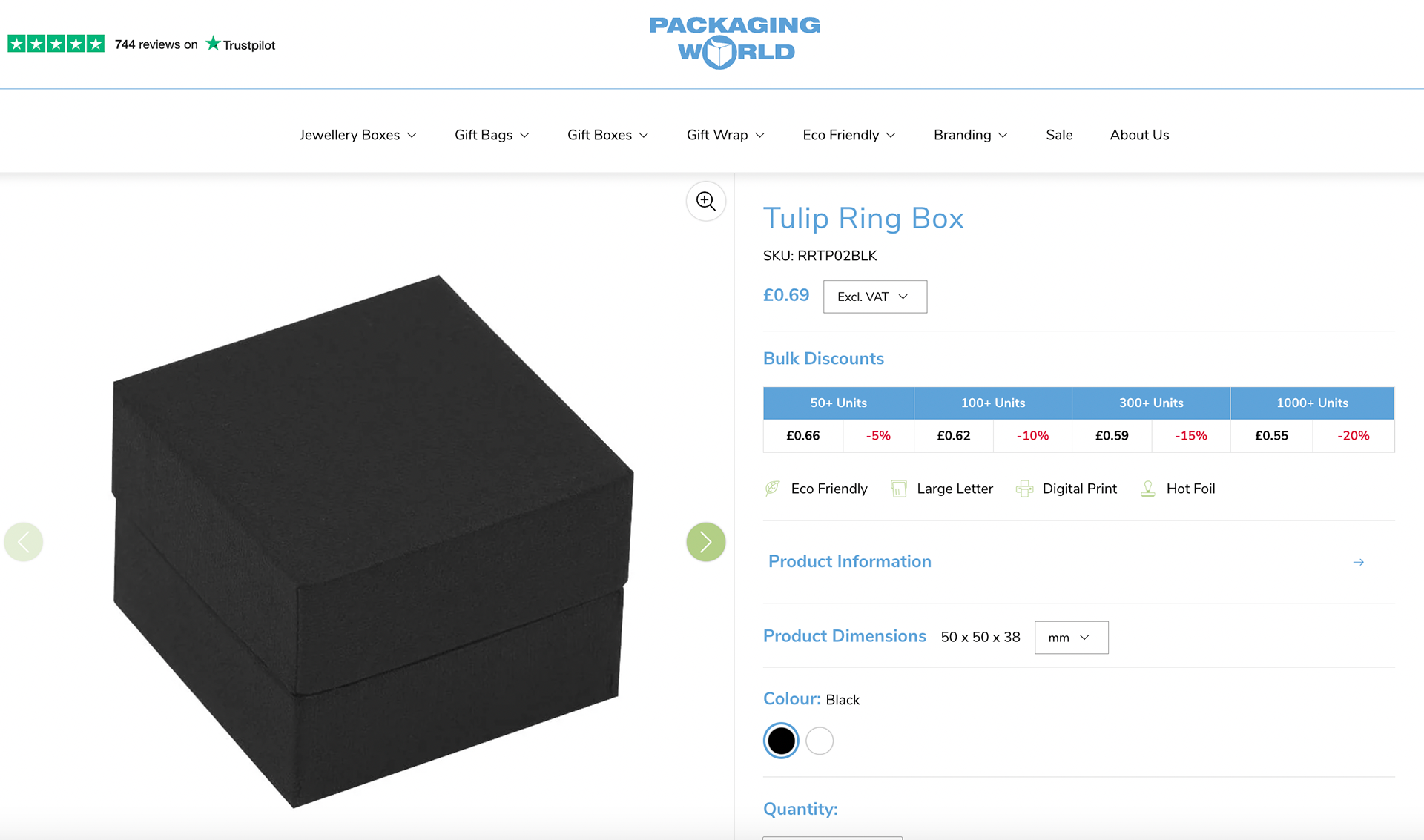


For packaging, I have found a series of different boxes that are coated in a black paper material and include a black cushion inside. I would be able to use these boxes and create my own branding, either with a lino print or foiling. I would also be able to bulk-buy these boxes to save money long-term. I feel as if black would be the best colour to use as it is neutral and would have a high contrast with the pieces inside. These would also photograph best when it comes to any promo and advertising.
Wages
a-n wages guide
When researching different wages, I found a large spectrum in the hourly wage. a-n has a table showing the different wages they suggest for different experience levels. As I would be a new graduate and would have yearly overheads of under 5k, the day rate is £168. This gives an hourly wage of £21.
However, if you look at an average graduate salary of £23,000 a year, this changes my hourly wage.
I took into account different costs I would have being self-employed, for example, subscriptions (Crafts Council and a-n) and packaging, equipment and postage. With a subscription from a-n, I would also have public liability insurance for any exhibitions, therefore this is not included separately in my figures. As all of the work for this project could be done from home, with casting being the exception, I wouldn't need a studio. However, I have set aside £25 per month for contributions towards electricity and heating costs for my home studio. In the future, I would like to be able to afford different equipment, for example, an enamelling kiln, and so have set aside £100 for materials and tools.
I also estimated how much money would be spent on promos, with this most likely being in the form of boosting Instagram posts and website hosting (square space starting at £7pm). I have used Instagram boost before, during lockdown and it proved to work very well, so I feel as if it is important to have this money accounted for.
For packaging, I have set aside £10 per month for boxes. I would then brand these boxes myself with a lino print or foil, to save costs.
While I hope to improve my photography skills, I also think it would be beneficial to have the funds to hire a photographer, even if it is just for a year or two while I'm getting more confident with my own work, and starting to create a brand for myself.
With all of these figures taken into account, and having 20 making hours a week, for 46 weeks a year, this leaves me with an hourly rate of £29.71
This results in labour costs of £624
Final Price
Using the formula of (wages+materials)x2 for the wholesale cost, and then wholesale x2 to allow for a gallery commission by Collect, results in my final pricing of £2907 for the collection of 3 brooches. While I think this is incredibly high for my pieces, I know that with practice and shortening the time taken to make my pieces would help lower the price. I believe that a lower price for my work would be more realistic to sell at Collect as a new artist, as I currently feel as if this price is pricing myself out of my market, and I know that this could be done by lowering my making time. I am regularly practising my wax carving and stone setting techniques, and know that with time I will be able to make designs much quicker.
If I were to sell the brooches separately, then the price would be £969 each, reaching the £500 minimum that Collect has.
Reflection
Throughout this project, I pushed myself to learn a new technique, lost wax casting. I used this technique as I knew that I would be able to achieve the ‘molten’ design that I wanted. While I initially found this very challenging, I found that working with wax is a valuable skill that I intend to carry forward in my future practice. However, I recognise that I still have much to learn and refine in this area, as evidenced by the final outcomes of my pieces.
With my final outcomes, I am not entirely satisfied with the results for many reasons, however, I do believe that I have successfully fulfilled my aim of turning something considered disgusting into a 'desirable' piece of jewellery.
When it comes to the brooch base, there are a few gaps or ‘dints’ in the cast. This has most likely come from the sprue placement while casting. Because I had to fit all 3 brooches into one plaster cast, I had to angle my brooches so that they would still fit within the suitable parameters of the casting 'walls'. This meant I had to angle one of my brooches slightly upwards. As I was only using one large sprue in the centre of the piece (as to not interfere with the brooch mechanism) it looks as if a small area hasn't been filled with brass. To prevent this from happening in the future, I will add more small sprues to any designs that need to be angled upwards, as this will allow for better flow of the metal during the casting process.
Once again with the brass casts, I accidentally scratched all of my pieces when I was using the diamond drill bits to remove any of the black residue after casting. I decided to use these drill bits as it was quicker than using Tripoli, however this ended up adding hours to my clean-up time. As shown in 'UC2 – Making', I went back in with the Tripoli to clean up as best as I could, however, I still think that there are a few scratches on my pieces, especially where I had used tiny diamond bits in between all of the textured pieces. The polishing tools that I have used are still too big to fit in between these textures, even when I tried making my own smaller tools. I had tried using the tumbling wheel as well, however, this was also unsuccessful. In the future, I will not use any diamond drill bits when I want a high-polish finish, as this made the refinement very difficult for me. However, I do want to explore how I can create different finishes on brass casts in the future using these tools. I also want to try and source any smaller polishing tools that would give me the high polish finish that I desire, or learn how I can adjust any tools that I own to reach the small areas. Nevertheless, I do belive that the brass compliments the warm tones of the bacteria stones.
When it came to creating the brooch mechanism, I am happy that I decided to cast the mechanism with brass, as I do believe that having the whole piece made from the same material makes it look more refined. However, I do need to perfect the height of these mechanisms and explore how the pin moves while using the brooch. Once I added the pins to the brooch, I immediately thought that the hook end of the mechanism needed to be about 2mm higher than it was. I had tested the mechanism in wax before casting, however, I believe the mechanism worked very differently in the wax compared to brass. There was more leeway with the wax, so I did not realise that I needed this change in height as it may have been pressing into the wax without me realising it. While I tried to use pliers to manipulate the brass into the correct shape, I now know that if I were to make this mechanism again then I would need to make the hooks slightly taller/longer, and use a magnifying glass with a higher magnification so I can confidently make decisions on the small details.
Brooch seen at Collect 2024, Goldsmiths Stand, unknown artist
With the overall design element of my brooches, once again I am not completely satisfied with the outcome. Even though I was happy with my watercolour designs, after I had finished making my pieces, something wasn’t sitting right with me. I feel as if this is for a few reasons. The stone setting element seemed obvious and predictable. While I had experimented with different prongs and different settings, I settled on a design with a simple four-prong setting. I did this because of the settings I had seen at Collect in March 2024, and because I wanted to highlight the stone, rather than any prongs.
However, what I didn't take into account was the shapes of the stones that were being set at Collect. Many of the stones using prong settings were of much more intricate and interesting cuts, for example, this brooch from the Goldsmiths Fair stand. My ‘stones’ were simple cabochon shapes, which while I was originally happy with them being of a simpler shape as to not take away from the bacteria, I feel as if this was the wrong decision. I feel as if the cabochon shape is too considerable and too consumable, and when paired with the traditional setting, communicates an obvious jewellery language. However, I am happy with how all the stones are unique and have a variety of colours and opacities. When reflecting on my final outcome, I definitely feel as if the stone setting aspect could have been pushed significantly more, and create a more dynamic and interesting design. If I were to make these again, I would also add more Cubic Zirconias to my design, and lean more into the illusion of the bacteria spreading.
I liked the chain that I had included in my design, however, if I were to make these brooches again, I would add a separate hook or clasp on the back of the brooches. I would prefer to have the chain with its own separate mechanism rather than simply sliding onto the chain. I feel as if this looks unrefined and the function seems difficult to hold in place. I would ideally use a spring clasp to create a secure fixing on the back for the chain.
If I carry on with bacteria stones in L6 I plan to explore different mould shapes, and making my own silicone moulds, so I can perfect the shapes that I want.
While photographing my brooches in context, I did struggle a lot. I found it very hard to find the right camera settings to capture the details while not having overexposed areas of the brooches. I first tried photographing these pieces in the box with professional lighting, however, these turned out to be unusable, even after editing. Thankfully, I had the daylight studio booked for the following week, and so retook all of my pictures. However, the camera that I was able to book could only shoot up to 16MP. These still did not turn out the way that I wanted them to, however, they were more usable than my other pictures after editing them. I found it very hard to focus on the whole brooch, even when using manual focus and adjusting the distance between the brooches and the lens. Throughout Level 6, I plan to make regular bookings in the daylight studio to practice my photography and editing skills, especially with reflective objects, and ask the photography technicians for support. Over the summer I also plan to gain my Adobe certification in Photoshop. This will help with my understanding of the programmes, and help me produce better-quality outcomes.
Reflecting on my work, I do question whether these pieces truly align with the collector-focused audience of Collect. I question whether they may be better suited for a gallery catering to wearables rather than collectables. However, I am confident that I could rework aspects of these pieces to better fit the market of Collect and similar exhibitions in the future. This could be done by exploring different stone settings, potentially ones that extrude from the base itself.
One gallery I feel that my work would be suited for is Diana Porter, in Bristol.
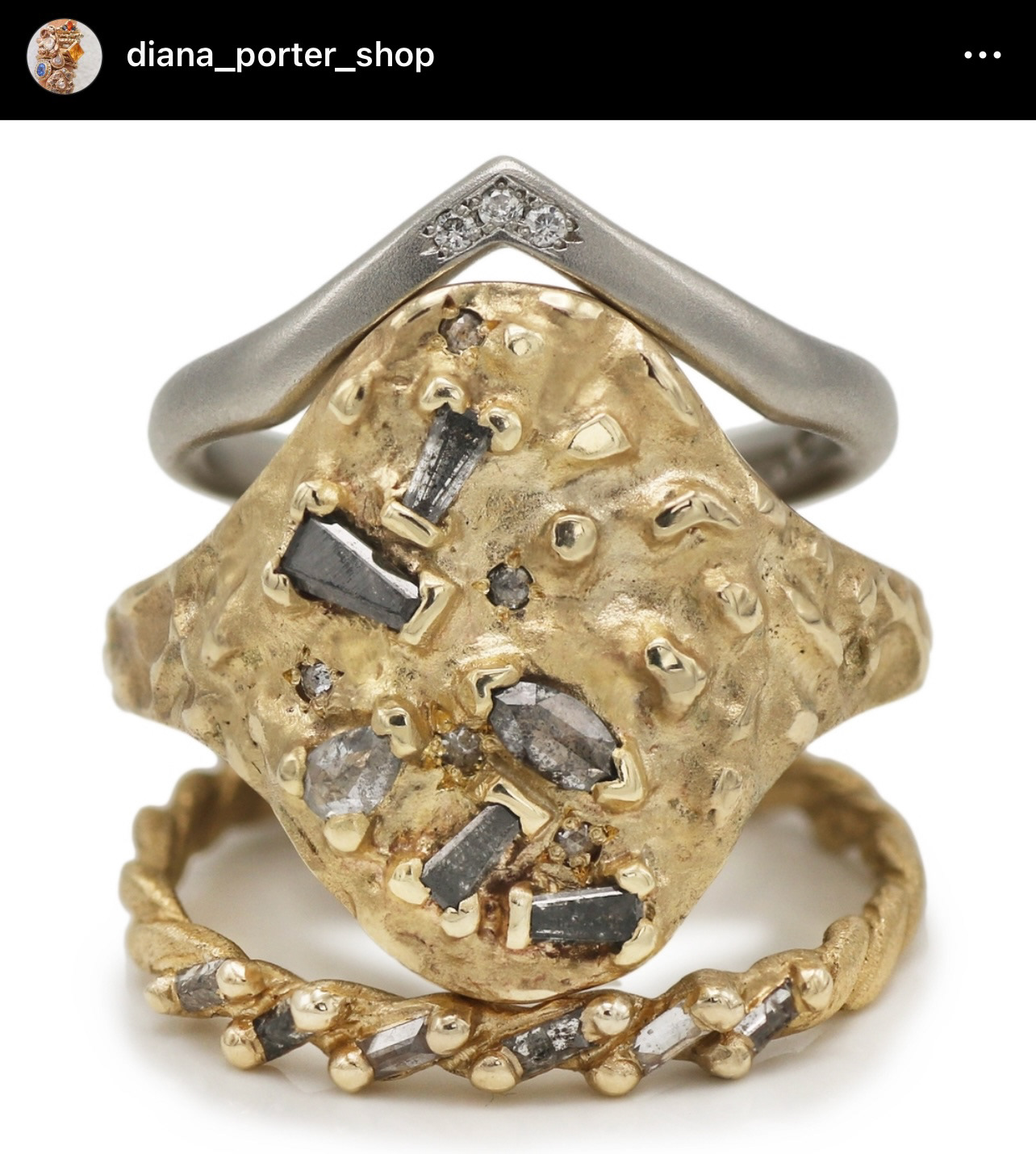
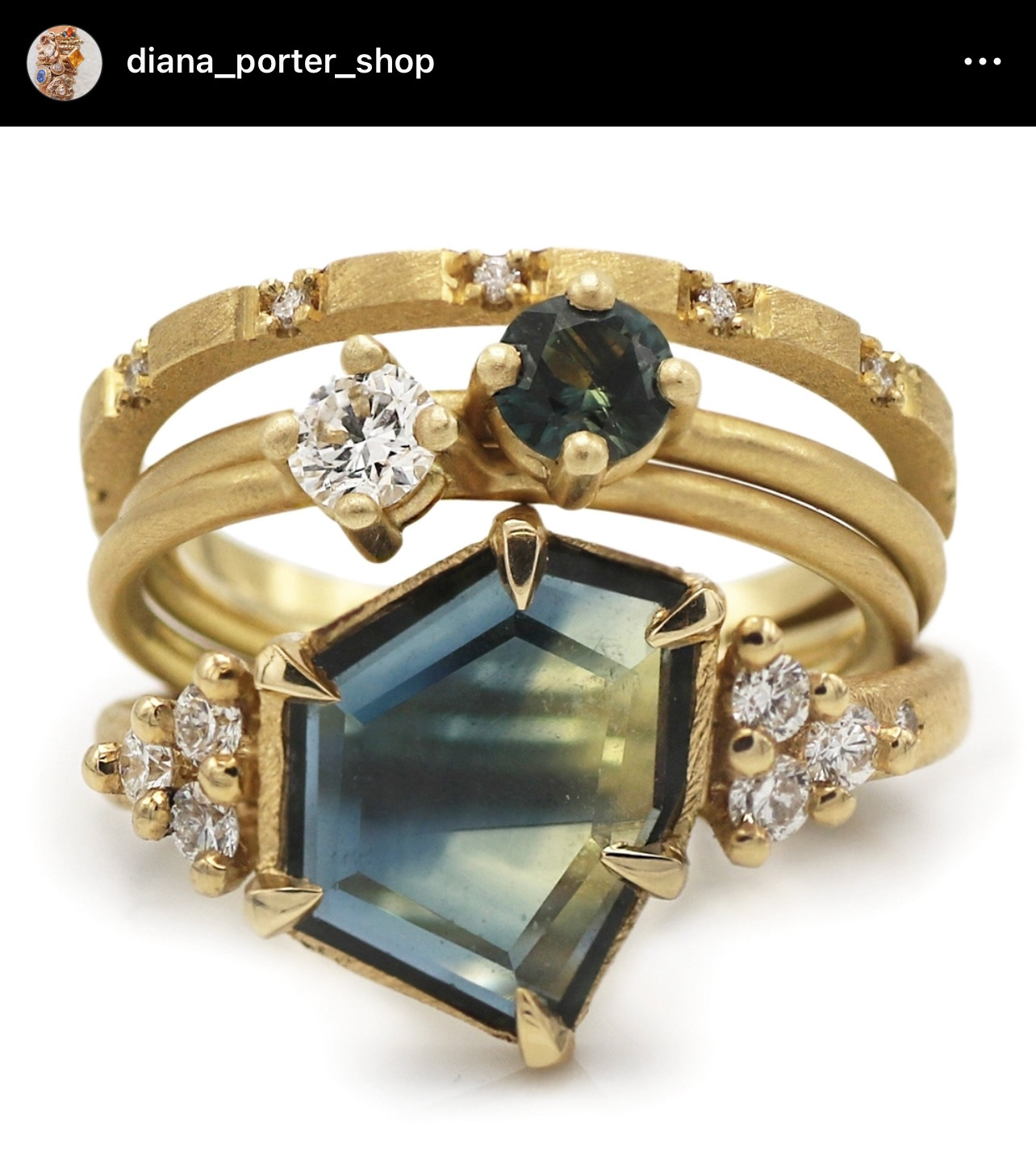


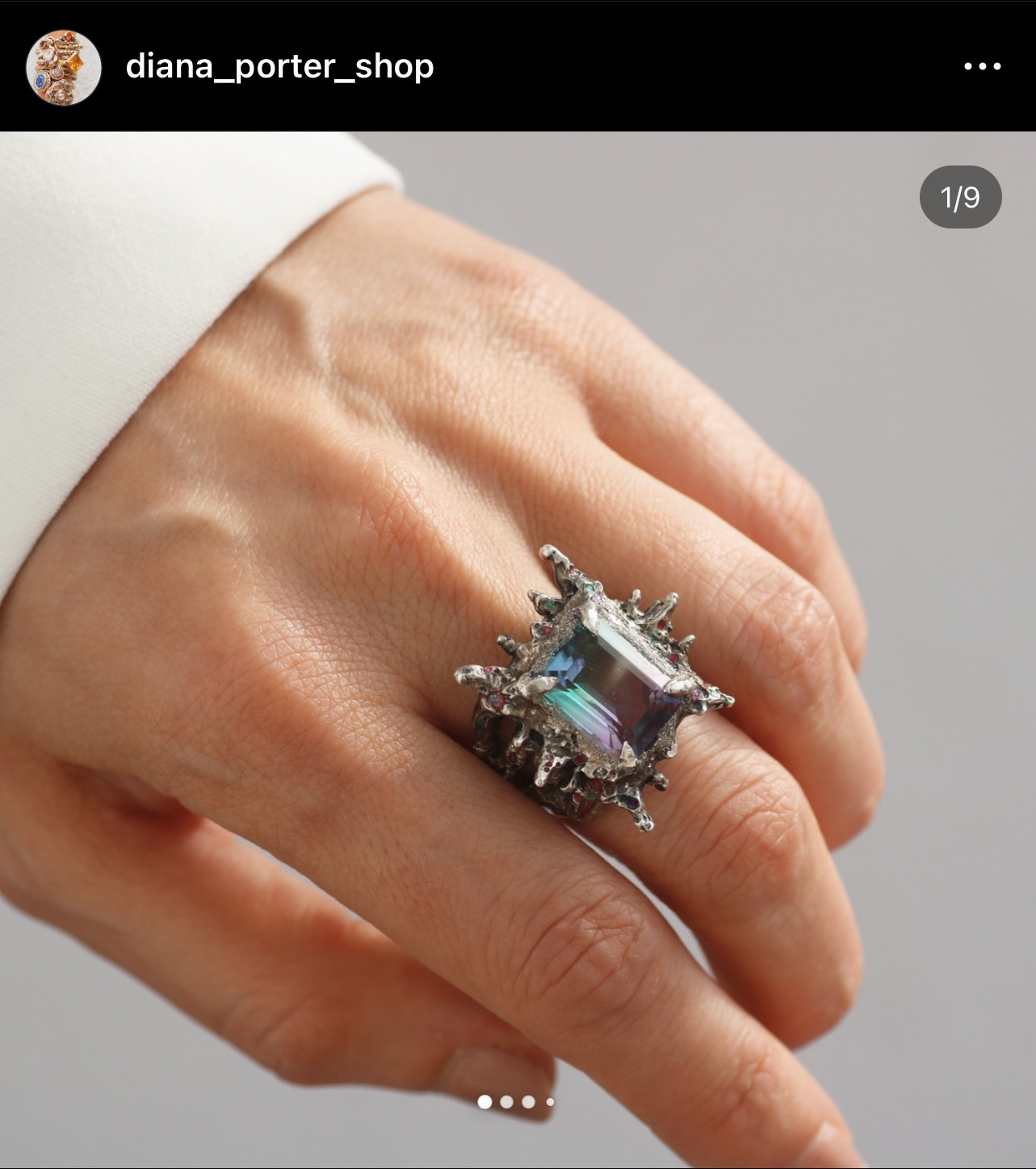
This gallery creates fine jewellery with experimental features and settings. While most of the work in the gallery is predominately rings, I do believe the style of my work is leaning more towards experimental fine jewellery.
I have learnt an extensive list of valuable lessons throughout this project, more than any other project before. I and am excited to continue exploring the narrative of bacteria and pushing the boundaries of my practice in Level 6, while challenging myself with technical aspects and my ability to refine my designs. I also plan to start regularly using finer materials, for example, precious stones and silver and gold. With gold, as I most likely won't be using solid gold, I would like to research how I can get my designs gold plated, as I would like to become familiar with the procedures as soon as possible. I would also like to send my work off to be hallmarked, to once again, become familiar with the process and make my work more suitable for exhibition.
